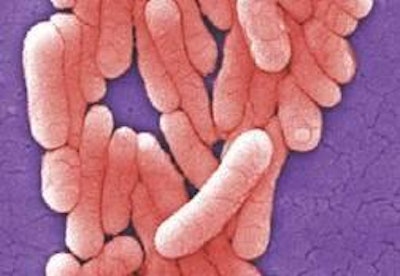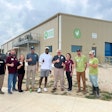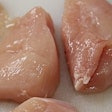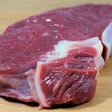
USDA FSIS proposed tighter pathogen reduction performance standards for Salmonella and Campylobacter on chilled broiler and turkey carcasses on the last day of 2009. As the industry strives to meet these standards, researchers continue to try and develop effective and practical control strategies. Unfortunately, Salmonella and Campylobacter organisms are not the easiest microbes to control and simple solutions have been hard to come by.
Difficult to culture and count
“Counting salmonella is relatively difficult and that is why the agency (USDA FSIS) uses positive or negative rather than enumerating the number of colonies on a carcass,” said John Cason, research physiologist, USDA ARS.
Speaking at the 2010 Carolina Poultry Processors Meeting, Dr. Cason said that the average Salmonella-positive broiler carcass has around 30 salmonella colony forming units on it. There is no normal distribution, some carcasses have many CFUs, but many carcasses have just a few Salmonella CFUs on them. Because of the relatively low number of CFUs per carcass, conflicting testing results split samples 40% to 50% of the time, according to Cason.
FSIS is not just tracking the incidence of Salmonella-positive carcasses post chill, the agency is also isolating some Salmonella colonies from samples and identifying the strain of Salmonella in the colony. In doing the strain identification, one colony is selected per plate sampled.
The methods used in enrichment of the sample affect the strains that found in a sample. “Method used varies by lab; we might not identify the causative agent in outbreaks,” he said. “Some strains grow better under certain conditions. We are finding the winners in the enrichment process and not necessarily the strain that caused people to get sick.” According to Cason, the probability of detecting a specific Salmonella strain had little to do with its starting concentration in the sample.
Even though Salmonella and Campylobacter organisms can be difficult to culture, enumerate and type, several strains are very well adapted to the digestive tracts of poultry. This makes controlling these organisms a real challenge.
Clean cages
“Step one (for pathogen control) is minimizing the load coming in on the birds,” said Dr. Julie Northcutt, professor and extension specialist, Clemson University. “Multiple interventions are required to meet the regulations, there is no silver bullet.” She explained that intervention steps to reduce pathogens on poultry carcasses involve washing, trimming and chilling.
Live haul is either the last step in the growing the birds or the first step in processing them; it is also a potential point of cross contamination, according to Dr. Mark Berrang, research microbiologist, USDA ARS. He said that live haul cages or coops containing fecal matter from previous flocks can be a source of Campylobacter on carcasses at the processing plant. Negative flocks can pick up Campylobacter from positive flocks just by being put in the cages used by the positive flocks.
Research has shown that washing the cages with water does lower the number of Campylobacter on the cages, but using a disinfectant after the water will not eliminate the residual Campylobacter. Drying the cages for 48 hours, even if they are not cleaned, eliminated the Campylobacter. Berrang said that spraying the cages to clean them and then drying them works best. If cages could be made with floors that could be changed out after use, then soiled floors could be cleaned, dried and reused later.
Contamination in the pickers
Gut contents squeezed out of the pickers are the main reason for the increase of Campylobacter contamination during picking, according to Berrang. He suggested three possible solutions, plugging the vent, removing gut contents prior to picking and killing Campylobacter in the gut prior to picking. Berrang said that food-grade acids placed in the vent before the scalder does reduce post picking Campylobacter numbers on carcasses. The Campylobacter numbers still go up when compared to the carcasses prior to picking, but the numbers don’t go up as much as in the controls.
Bird washers and brushes
Poultry plants employ numerous carcass rinses, inside-outside bird washers (IOBWs) and brushes to clean carcasses and, hopefully, reduce bacterial loads on the carcasses. Northcutt said that research demonstrates that IOBWs don’t reduce pathogens, but that USDA FSIS recommends their use with chlorine. She said that the same amounts of E. coli are recovered from a carcass washed once as from a carcass washed three times, with or without 50 parts per million of chlorine.
Northcutt said that the temperature of the water used in the IOBW has no impact either. She noted that at least one poultry company uses 110 F water in its IOBWs. Chlorine in the IOBW has too little contact time to kill the bacteria. She said that carcasses rinsed with 500 parts per million of chlorine had the same percentage of positive carcasses as those rinsed with sterile water. Washing the bird is the main affect of the IOBW. Agitation is important for removing bacteria, and chlorine can kill the detached bacteria.
Washers and brushes can still be part of an effective multi-hurdle approach to reducing pathogens on carcasses. Berrang said that tests were done at a poultry plant that had numerous wash cabinets and had bird brushes before the scalder and before evisceration. He said that there were no statistically significant reduction in pathogens caused by an individual washer or a brush, but combining all of the steps gave a statistically significant reduction.
Chilling works
Immersion chilling in water with a bactericide significantly reduces the amount of Campylobacter and Salmonella on poultry carcasses. Northcutt said that research has shown that dramatically increasing the amount of water used per pound of meat in the chiller has little effect on the pathogen numbers on the carcasses.
Finishing chillers act like a dip tank to give total immersion of the carcasses in a solution of clean makeup water and a biocide. Contact time in the finishing chiller can be from 15 seconds up to a couple of minutes. Finishing chillers can be effective at reducing pathogen incidence on carcasses.
Berrang said that in research comparing air-chilled carcasses to immersion-chilled carcasses, the air-chilled carcasses had slightly more Campylobacter than did immersion-chilled carcasses. He said that there were the same subtypes of Campylobacter in the immersion and air-chilled carcasses.
Salmonella enteriditis
USDA FSIS is looking at using the Poultry Improvement Plan (PIP) to track Salmonella enteriditis (SE) in broilers and will consider positive flocks to be adulterated, according to Northcutt. If SE-positive flocks are considered to be adulterated, then the industry would have to process them differently.
"SE positive flocks will have to be slaughtered and kept separated from other flocks and the meat would have to go into ready-to-eat products,” Northcutt said. “This really concerns me.”
FSIS has been tracking the serotypes of salmonella colonies that it isolates from carcass rinse samples. As poultry companies have reduced the incidence of some common salmonella types on broiler carcasses, the percentage of the positive samples that have been identified as SE have increased. Since the total number of positive samples has decreased, the number of birds with SE could remain at the same level as before but the percentage of SE-positive birds would increase as the total number of positive birds has decreased.



















